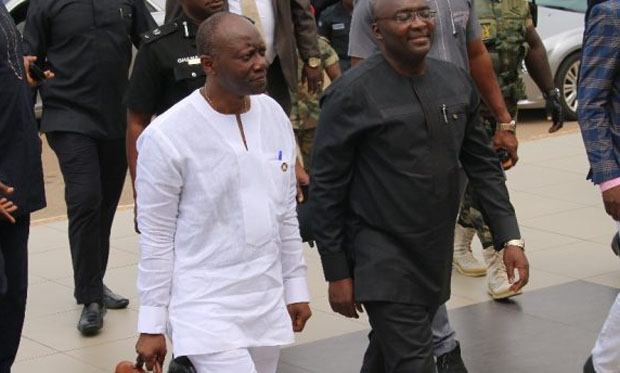Vice President Dr Bawumia and Ken Ofori Atta at the Parliament House yesterday
Ghana’s gross public debt stock in nominal terms stood at GH¢154 billion (US$32.00 billion) as at the end of May 2018, representing 63.8 percent of GDP compared to 66.8 percent in the same period in 2017.
Presenting the Mid-Year Budget Review to Parliament yesterday, the Finance Minister Ken Ofori Atta said out of the total public debt, external debt at end May 2018 amounted to GH¢81.7 billion (US$18.5 billion), whereas domestic debt amounted to GH¢72.6 billion (US$16.4 billion), representing 53.0 percent and 47.0 percent of the total public debt stock, respectively.
As a percentage of GDP, he said, external and domestic debt represented 33.8 percent and 30.0 percent respectively.
Expenditure
According to him, total expenditure, including arrears clearance, amounted to GH¢23,756 million (9.8% of GDP) and constituted 38.3 percent of the annual 21 budget target, adding that although the outturn was 3.2 percent lower than the programmed target of GH¢24,553 million, moderate slippages were observed in the wage bill (GH¢279.6 million) and Goods and Services (GH¢134.1 million).
Employee compensation
Expenses on compensation of employees amounted to GH¢8,141.2 million, exceeding the programmed target by GH¢133.9 million or 1.7 percent.
Of this amount, expenses on wages and salaries amounted to GH¢7,131.6 million, 4.1 percent higher than the programmed target of GH¢6,852.0 million and accounting for the overage in compensation of Employees.
“The reason for the slippage is attributed to budget overruns recorded by the Ministries of Education and Health. Corrective measures such as the complete roll out of the HRMIS are being employed to ensure that the excess are curtailed in the second half of the year.”
He revealed that similarly, expenses on the use of goods and services, which amounted to GH¢1,627.0 million, was about 9.0 percent higher than the programmed target, adding that the slippage was mainly attributed to front-loaded expenditures, including those for the purchase of fertilizer for the Planting for Food and Jobs programme.
“These overruns are not expected to recur in the second half of the year.”
Interest payment
According to him, interest payment remained within the programmed target for the period but was expected to pick up, given the impact of the bond issued by government on behalf of GCB Bank on the Purchase and Assumption of UT Bank and Capital Bank.
Lower tax impact
Grants to other government units, comprising transfers to Statutory and Earmarked Funds such as the National Health Insurance Fund (NHIF), the Ghana Education Trust Fund (GETFund), the District Assemblies Common Fund (DACF), among others, remained lower than the programmed target mainly on account of lower tax revenues and reported IGF retained by MDAs, he noted.
CAPEX
Total CAPEX, comprising Domestically Financed CAPEX and Foreign Financed CAPEX, was 39.6 percent lower than target, he said.
“Although Domestically Financed CAPEX was below target, it showed a stronger performance, compared to the same period in 2017 and 2016. Domestically Financed CAPEX amounted to GH¢438.4 million (or 13.1 percent of the annual target) compared to a programmed target of GH¢1,125.4 million.
“It should be noted, however, that commencement certificates amounting to about GH¢1,000 million have been issued for capital projects.”
Additionally, he said a significant portion of programmed arrears for 2018 has been cleared compared to the programmed target.
“Total clearance of arrears amounted to GH¢807.4 million against a target of GH¢394.9 million. The total clearance constitutes 94.1 percent of the annual target.”
By Samuel Boadi


